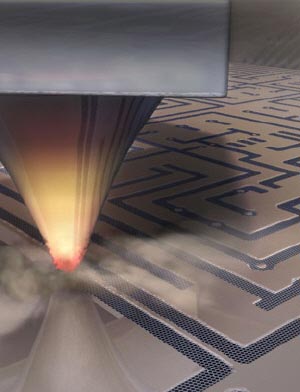
A simple one-step process to create nanometre-sized circuits from graphene has been developed by researchers in the US and France. The new technique involves “writing” electrically conducting nanowires onto graphene oxide using a tiny heated tip and could be ideal for making flexible electronic devices.
Graphene is a honeycomb-like sheet of carbon just one atom thick with a number of unique physical properties. Because of these properties, many researchers believe that graphene could replace silicon as the electronic material of the future. For example, it could be used to make ultrafast transistors because electrons move through it at extremely high speeds.
Single sheets of graphene are also transparent to light, a property that could be exploited to make displays, touch-sensitive screens and solar cells. Graphene could allow for lower-cost components and greater screen flexibility than current materials.
But for graphene-based technologies to be commercially viable, researchers must first develop technologies to create graphene circuits on a large scale using reproducible and reliable techniques. For example, existing methods “cut” nanowires out from a sheet of graphene and re-assemble them to make circuits.
Thermochemical nanolithography
But things may be a lot simpler where graphene is concerned. Paul Sheehan of the Naval Research Laboratory in Washington, Elisa Riedo at Georgia Tech and colleagues have now exploited the fact that graphene oxide, which is an insulator, converts back to conducting graphene when heated. However, instead of heating the entire sample, the researchers used a hot atomic force microscope (AFM) tip to convert very narrow ribbons, measuring just 12 nm across, into reduced graphene.
The technique is precise, which means that the rest of the graphene oxide sample remains insulating. Writing with different tip temperatures, from 130 °C upwards, also allows the electronic properties of the nanowires to be tuned over four orders of magnitude, making the wires more or less conducting.
“The beauty of our technique is that we have devised a simple, robust and reproducible technique that enables us to change an insulating sample into a conducting nanowire,” said Sheehan, who heads the Surface Nanoscience and Technology Center at the NRL. “The flexibility of the technique also allows the nanowires to be written before or after transfer of the graphene to a receiving material,” he told our sister website nanotechweb.
‘Very promising’
“The process – called thermochemical nanolithography – of changing the chemistry of a material with a hot nanotip is very promising and we are able to write semiconducting or metal lines in an insulating matrix by using an array of tips heated at different temperatures,” added Riedo.
According to the team, which includes researchers from the University of Illinois and the Institut Néel in Grenoble, the nanowires conduct better than doped amorphous silicon and compare well to most doped polymer conductors. However, unlike these other materials, all of the conduction occurs in a single layer of atoms in the sample.
While the research is still in its early days, it is possible that the new technique could be extended so that arrays of AFM tips rapidly write circuits at high rates across graphene wafers. Graphene could be a sort of nanoscale “electronic breadboard”, says Sheehan.
‘Rich and surprising field’
“Graphene and chemically modified graphenes, like graphene oxide, are exceptionally promising materials,” he added. “So much is known about carbon chemistry and so much has been learnt recently about carbon nanotubes that yet has to be applied to graphene. I think this will be rich and surprising field for a while to come.”
The researchers are now extending their work to single graphene sheets that have been transferred onto silicon wafers.
The results are described in Science.



